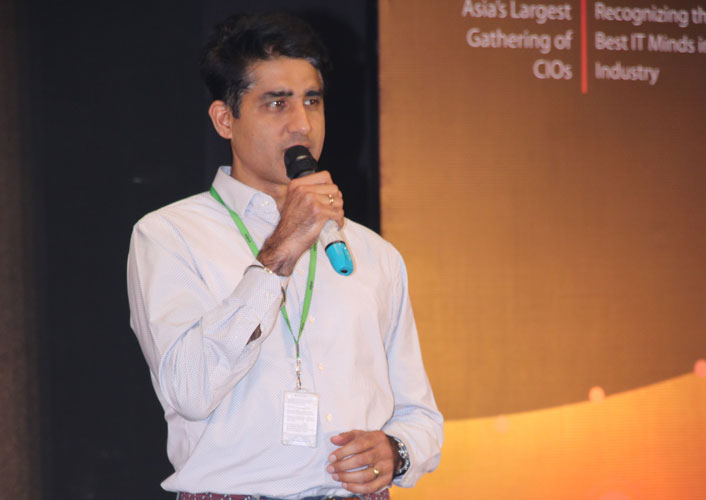Rohit Adlakha, Chief Digital Officer, Chief Information Officer, Chief Automation and AI Officer and Chief Experience Officer at Wipro Holmes.
In his address, Rohit Adlakha from Wipro Holmes speaks about the digital disruption in the industry and how CIOs need to reposition themselves within the changing scenario.
The industries today are on a journey of absolute disruption and digital transformation triggered by new-age technologies like AI, ML, Edge Computing, Automation, etc. It is being referred to as the 4th industrial revolution. The revolution has penetrated the industries in such a way that all companies are going through their individual digital and AI journeys. “People often ask me what I mean by Digital. In my view digital is all about speed, agility, breaking down the siloes, looking at design thinking, looking at user experience, etc,” said Rohit Adlakha.
Delivering his guest knowledge session on the first day of CIO 500 Conclave & Awards 2019, Rohit Adlakha from Wipro Holmes spoke about the Digital Disruption and the CIO’s position within it. Rohit Adlakha occupies the positions of Chief Digital Officer, Chief Information Officer, Chief Automation and AI Officer and Chief Experience Officer at Wipro Holmes.
“AI has taken over the entire world. The fact is that today AI has become the biggest digital disrupter in the industry. It is not just humans that a CIO needs to manage, but they also have to manage bots, scripts and software. And when AI sits in the Cloud, especially public cloud, imagine what happens to security, governance and compliance and how do you measure them? In this world of Amazon and Uber, everyone is talking about anytime, anywhere, any device, any network access. What does that mean?” asks Rohit.
He goes on to say that in the context of an individual enterprise, when people talk about the employees in the company, it is potentially about all connected devices within that enterprise. So, what is the role of IT there? Is it only about the Data centre? Is it only the application landscape? Is it the hybrid cloud? Is it the end users? Or is it about managing all the connected devices within the company?
Sharing his experience Rohit says, “Our own estimate within Wipro is that these number of connected devices will be a much greater number than the number of employees we have. We have mobile handsets ranging from Android to iOS, We have operating systems which are Microsoft, Chrome, iOS. We have devices which could be HP, Dell, IBM, Lenovo, Apple. We have browsers which range from Chrome to Internet Explorers to Bing. We have communication happening through email which could be on Google Suite or on Microsoft Outlook. Then we have call conferencing capabilities from Cisco and Microsoft. Imagine CIOs having to manage this entire complexity where we can pick up our choice of in terms of any combinations and each of these combinations could be upto 100. Imagine the complexities that CIOs have to manage.”
A key factor of this digital disruption is that the culture of users is changing dramatically. People are talking about open offices, home offices and virtual offices. The fact is that the workforce has become more culturally diverse. By 2025, 75% of the workforce will be millennials. Cloud sourcing is going to be big. It is estimated that in the US, about 33% of the workforce is going to be outsourced or freelancers. It is easier to manage people in a room using one common wifi network and a common security policy. But how do you take care of people who are distributed across different spaces? So, the role of the CIO is going to change in terms of culture, types of users, types of bots, and it is going to become very complex, explains Rohit Adlakha.
Rohit simplifies the scenario with the example of Amazon. Their user interface is intuitive, everything is based on service based architecture and the entire self help-UI is so simplistic that 99% of the time, the customers need not have to reach a human. That is the exact experience people are looking at within the enterprise. So, user experience and operational security is going to be the key in this complex world.
“CIOs have to make sure that the business and IT alignment is there, which means shifting from operations to business, looking at the different sets of parameters. For instance, if you have onboarding new employees, can you give them a laptop, a user id password, access privileges, IT badge and everything else the minute that they join? So, the business and IT alignment, driving the company’s revenues and profitability is how the CIO should reposition themselves,” says Rohit.
Commenting on the challenges faced by the CIOs, Rohit says, “It is about security and trust. There is a natural connection between Cloud and Edge. It is looking at Zero Trust which is your identity, managing of assets and doing segmentation rather than having local networks. So, that every transaction you do, checking your email, logging on your laptop, whatever communication may happen, should happen with security and trust – that is the challenge a CIO has to tackle.”
Concluding his address, Rohit Adlakha asserts, “The pride of the CIO function is in answering how transformative and disruptive can you be. The whole idea is to become disruptive, innovative, and translating employee productivity and uptime into profits for the company. That is the differentiation that a CIO brings. And that is why the challenging task for a CIO is to constantly reinvent yourself.”


